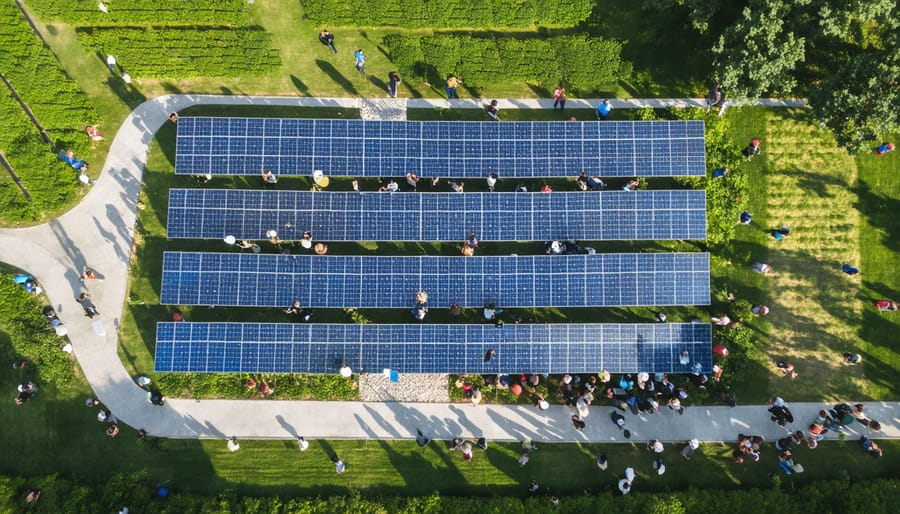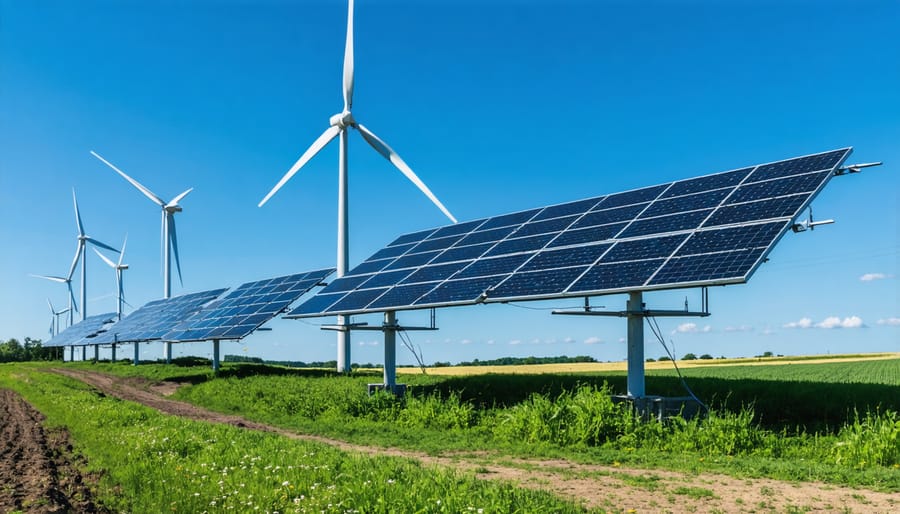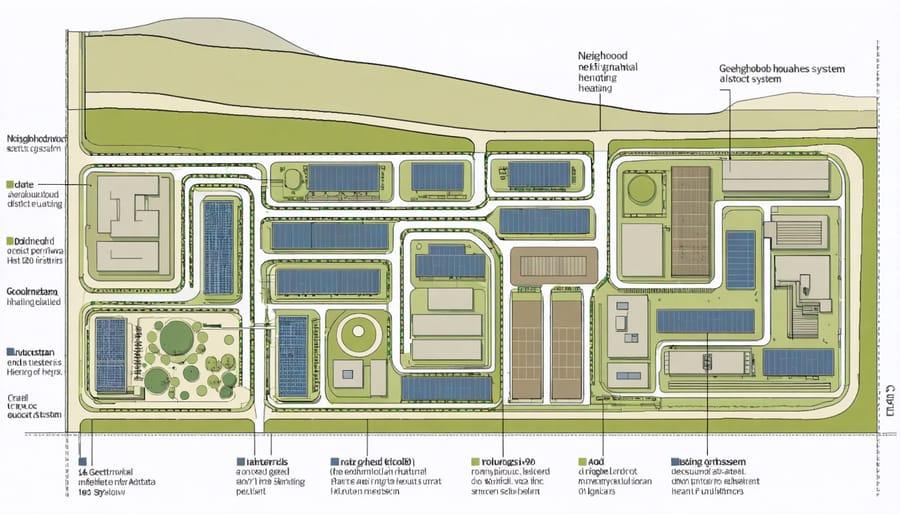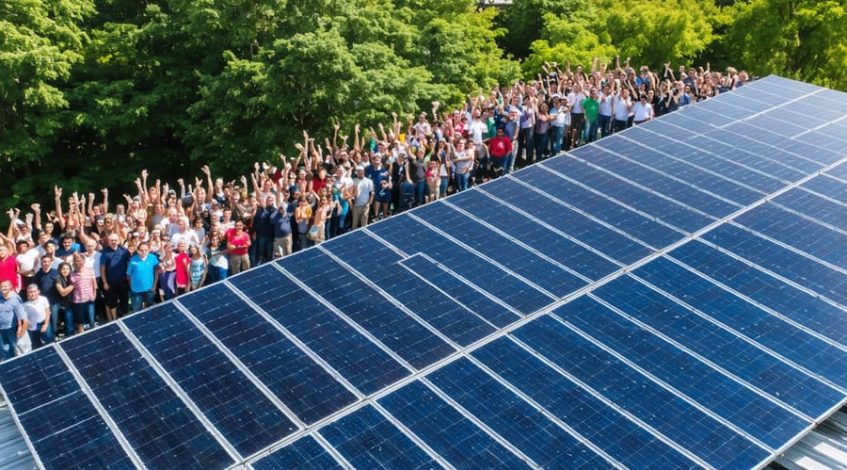Transforming our energy landscape requires strategic implementation of proven renewable energy initiatives that deliver both environmental and economic benefits. As communities worldwide pivot toward sustainable power sources, five renewable energy technologies stand at the forefront of this evolution: solar, wind, hydroelectric, geothermal, and biomass energy. These solutions not only offer reliable alternatives to fossil fuels but also present compelling opportunities for community-scale development and long-term cost savings. With global renewable energy investments reaching $366 billion in 2021, forward-thinking organizations are increasingly recognizing the competitive advantage of early adoption. This comprehensive guide examines each renewable resource’s practical applications, implementation requirements, and potential return on investment, providing decision-makers with essential insights for sustainable energy planning.
Solar Power: The Cornerstone of Community Energy
Community Solar Gardens
Community solar gardens represent an innovative approach to renewable energy adoption, allowing multiple participants to benefit from a single solar installation. These shared solar installations are typically large-scale projects strategically located on open land or commercial rooftops, enabling residents and businesses without suitable properties for individual solar panels to access clean energy.
Participants subscribe to a portion of the solar garden’s output, receiving credits on their utility bills proportional to their share of the project. This model proves particularly valuable in urban environments where apartment dwellers, renters, and businesses in shared buildings face limitations installing traditional solar systems.
The benefits extend beyond individual subscribers. Community solar gardens create local jobs, strengthen grid resilience, and help municipalities meet their renewable energy goals. For example, the Wright-Hennepin Solar Community in Minnesota serves over 100 households while generating 400 kW of clean electricity annually.
From a business perspective, these projects offer attractive returns through economies of scale, simplified maintenance, and optimized positioning for maximum solar exposure. Property owners can monetize underutilized land or roof space, while subscribers typically save 10-15% on their electricity costs without upfront installation expenses.
For local governments, community solar gardens provide a practical solution for expanding renewable energy access while promoting energy equity and economic development within their jurisdictions.

Rooftop Solar Cooperatives
Rooftop solar cooperatives represent an innovative approach to renewable energy adoption, combining the benefits of economies of scale with community-driven sustainability initiatives. These programs enable multiple property owners to collectively purchase and maintain solar installations, significantly reducing individual costs while maximizing energy generation potential.
Through group purchasing power, participants typically save 15-30% on installation costs compared to individual installations. The cooperative model also streamlines the procurement process, with experienced administrators handling vendor selection, quality control, and contract negotiations. This collaborative approach particularly benefits small and medium-sized businesses that might otherwise find solar installation costs prohibitive.
Successful implementations include the Solar United Neighbors program, which has facilitated over 6,000 residential installations across multiple states, and the Solarize Portland initiative, which achieved a 15% reduction in installation costs through bulk purchasing. These programs often incorporate shared maintenance agreements, ensuring optimal system performance through regular inspections and coordinated repairs.
The cooperative structure extends beyond initial installation, encompassing ongoing maintenance and monitoring services. Members share the costs of professional maintenance teams, advanced monitoring systems, and emergency repairs, resulting in better system performance and longer equipment lifespan. Some cooperatives even implement shared insurance policies, providing comprehensive coverage at reduced rates.
For business districts and multi-tenant buildings, rooftop solar cooperatives offer an efficient way to transition to renewable energy while distributing both costs and benefits among participants. This model has proven particularly effective in urban areas where individual building owners might face space or structural limitations.
Wind Energy: Powering Local Economics
Small-Scale Wind Cooperatives
Small-scale wind cooperatives represent a growing trend in community-based renewable energy initiatives, offering local stakeholders the opportunity to jointly invest in and benefit from wind power generation. These projects typically involve multiple property owners or community members pooling resources to install and operate wind turbines that generate between 100kW to 5MW of power.
The cooperative model allows communities to share both the initial investment costs and ongoing returns, making wind energy more accessible to smaller municipalities and rural areas. Successful implementations often feature 2-5 turbines strategically placed on shared or leased land, with power either used directly by cooperative members or sold back to the grid through power purchase agreements.
Management of these projects typically involves a board of directors elected by cooperative members, who oversee operations, maintenance, and financial distribution. Modern wind cooperatives often utilize smart monitoring systems and professional maintenance services to ensure optimal performance and longevity of the equipment.
Notable examples include the Middelgrunden Wind Cooperative in Denmark, which demonstrates how community ownership can drive local economic benefits while contributing to renewable energy goals. This model has been successfully replicated in numerous communities across Europe and North America, providing templates for future implementations.
Hybrid Wind-Solar Systems
Hybrid wind-solar systems represent one of the most efficient approaches to community-scale renewable energy generation, combining the complementary strengths of both technologies. These integrated systems leverage the fact that wind speeds are often higher during evening hours and cloudy days, while solar panels perform optimally during daylight hours, creating a more consistent power supply throughout the day.
A well-designed hybrid system typically reduces energy storage requirements by 50% compared to single-source installations. Communities implementing these systems often experience enhanced grid stability and reduced dependency on backup power sources. For example, the Danish island of Samso achieved energy self-sufficiency through strategic placement of wind turbines alongside solar arrays, creating a reliable year-round power supply for its 4,000 residents.
The economic advantages are equally compelling. Initial installation costs are offset by reduced infrastructure requirements, as both technologies can share transmission lines and control systems. Maintenance schedules can be optimized, and the diversified energy sources provide a natural hedge against resource variability. Recent studies indicate that hybrid systems can achieve a 15-20% higher return on investment compared to standalone wind or solar installations.
Modern monitoring systems and smart grid integration enable these hybrid systems to automatically optimize power generation based on real-time weather conditions and demand patterns, making them increasingly attractive for community-scale implementation.

Biomass Energy: Local Waste to Local Power
Agricultural Waste Programs
Agricultural waste programs represent a significant opportunity for communities to convert organic farm byproducts into renewable energy. Through anaerobic digestion and biomass conversion processes, materials such as crop residues, animal manure, and food processing waste become valuable energy resources. These programs typically involve collecting waste from local farms, processing it in centralized facilities, and distributing the generated energy back to the community.
Modern agricultural waste facilities can process up to 100,000 tons of organic material annually, producing enough electricity to power thousands of homes while reducing methane emissions from decomposing waste. Communities implementing these programs often see a 30-40% reduction in waste management costs while creating new revenue streams for local farmers.
The success of agricultural waste programs depends on strong partnerships between farmers, utility companies, and local governments. For example, the Danish city of Aarhus powers 12,000 households through its agricultural waste-to-energy facility, demonstrating the scalability of these initiatives. Besides energy production, these programs provide additional benefits such as organic fertilizer production and improved waste management practices, making them an increasingly attractive option for agricultural communities seeking sustainable energy solutions.
Urban Waste Management
Urban waste management has emerged as a innovative solution in renewable energy generation, transforming municipal challenges into sustainable power opportunities. Through advanced organic waste conversion technologies, cities can now convert household waste, food scraps, and other municipal solid waste into valuable energy resources. This process not only addresses waste disposal issues but also generates electricity and heating for local communities.
Modern waste-to-energy facilities employ sophisticated sorting systems and controlled combustion processes to maximize energy recovery while minimizing environmental impact. A typical facility processing 1,000 tons of municipal waste daily can generate enough electricity to power approximately 25,000 homes while reducing landfill usage by up to 90%.
The implementation of waste-to-energy projects offers multiple benefits: reduced landfill dependency, decreased methane emissions, and creation of local jobs. Cities like Copenhagen and Stockholm have successfully integrated these systems, demonstrating that urban waste management can be both environmentally responsible and economically viable. For municipalities seeking sustainable solutions, waste-to-energy technology represents a practical approach to achieving renewable energy goals while solving waste management challenges.
Hydropower: Small-Scale Water Solutions
Micro-Hydro Systems
Micro-hydro systems represent an efficient and reliable renewable energy solution for communities near flowing water sources. These systems harness the power of small streams or rivers, typically generating between 5 to 100 kilowatts of electricity – enough to power 5-100 homes, depending on water flow and system capacity.
Unlike large hydroelectric dams, micro-hydro installations have minimal environmental impact and require relatively simple infrastructure. The systems divert a portion of the water flow through a turbine before returning it to the stream, maintaining natural water cycles and aquatic ecosystems.
The technology offers remarkable cost-effectiveness, with systems typically paying for themselves within 5-10 years through reduced electricity costs. Maintenance requirements are minimal, and well-designed systems can operate continuously for 20-25 years with proper care.
Several communities have successfully implemented micro-hydro projects. For example, the town of Warren, Vermont, installed a 100kW system that powers municipal buildings and generates surplus electricity for the grid, saving approximately $40,000 annually in energy costs.
For areas with suitable water resources, micro-hydro presents a viable option for sustainable, community-scale power generation with predictable output regardless of weather conditions.
Run-of-River Projects
Run-of-river hydroelectric projects offer a sustainable approach to power generation while minimizing environmental impact compared to traditional dam systems. These facilities harness the natural flow of rivers without requiring large reservoirs, preserving local ecosystems and maintaining natural river patterns.
From an environmental perspective, run-of-river projects help maintain fish migration routes and protect riparian habitats. The continuous flow ensures downstream water quality and sediment transport remain largely undisturbed, supporting both aquatic life and downstream agricultural needs.
Communities benefit significantly from these installations through reliable power generation and economic development. Local jobs are created during construction and maintenance phases, while the consistent energy production supports industrial growth and reduces electricity costs. Many projects also incorporate recreational facilities and educational programs, enhancing community engagement with renewable energy initiatives.
Recent successful implementations in regions like British Columbia and Norway demonstrate the viability of run-of-river projects. These facilities typically achieve capacity factors of 40-60%, providing stable baseload power while maintaining environmental stewardship. The relatively small footprint and minimal infrastructure requirements make them particularly suitable for remote communities seeking energy independence.
Geothermal: Tapping Earth’s Energy

District Heating Networks
District heating networks represent an innovative approach to sustainable community energy, utilizing geothermal resources to provide heating and cooling for entire neighborhoods. These systems tap into underground thermal energy through a centralized plant, distributing heat through an insulated pipe network to multiple buildings simultaneously.
In successful implementations like the Paris-Saclay district heating network, this technology has demonstrated up to 60% reduction in carbon emissions compared to traditional heating methods. The system’s efficiency increases with scale, making it particularly attractive for urban developments and campus environments.
For property developers and municipality managers, district heating networks offer compelling advantages: reduced maintenance costs, improved energy security, and stable pricing structures. Modern systems can integrate multiple renewable sources, including waste heat from industrial processes and solar thermal energy, creating a resilient and adaptable energy infrastructure.
The initial investment, while substantial, typically delivers returns within 8-12 years through reduced operational costs and energy savings. Several European cities have proven this model’s viability, with some networks operating successfully for over 50 years.
Ground Source Heat Pumps
Collective installation programs for ground source heat pump systems offer communities significant advantages through economies of scale. By coordinating multiple installations simultaneously, neighborhoods can reduce per-unit costs by 20-30% while streamlining permits and installation logistics. These programs typically involve partnering with certified contractors who can efficiently deploy equipment and sharing underground loop infrastructure among multiple properties.
Maintenance programs further enhance system longevity and performance through scheduled inspections, filter replacements, and performance monitoring. Many communities establish service agreements with local HVAC professionals, securing preferential rates for routine maintenance. This coordinated approach ensures optimal system efficiency while reducing individual homeowner responsibilities.
Success stories include developments like The Pinehurst Community in Oregon, where 150 homes share a district ground source system, resulting in 40% lower installation costs and annual energy savings of $800 per household. Such programs demonstrate the viability of large-scale geothermal adoption when properly organized and maintained.
Community-led renewable energy initiatives have demonstrated remarkable success in transforming local energy landscapes while creating sustainable economic opportunities. These projects have consistently shown that when communities take charge of their energy future, they achieve multiple benefits beyond environmental preservation, including reduced energy costs, increased energy security, and strengthened local economies.
The future outlook for renewable energy implementation at the community level is exceptionally promising. Technological advancements continue to drive down costs while improving efficiency, making renewable energy solutions increasingly accessible to communities of all sizes. Industry projections indicate that by 2030, community renewable energy projects could account for up to 30% of total energy generation in many regions.
Success stories from diverse communities worldwide provide compelling evidence of the transformative power of renewable energy initiatives. From rural cooperatives utilizing wind power to urban neighborhoods implementing solar microgrids, these projects showcase the versatility and adaptability of renewable solutions to various community contexts.
Looking ahead, the integration of smart grid technologies, enhanced storage solutions, and improved distribution systems will further amplify the impact of community renewable energy projects. As more communities recognize the economic and environmental benefits of renewable energy, we can expect to see accelerated adoption rates and innovative implementation models that will shape the future of sustainable energy development.
The momentum behind community-led renewable initiatives continues to build, supported by favorable policies, technological innovations, and growing public awareness of climate change. This convergence of factors positions renewable energy as a cornerstone of community development and environmental stewardship for generations to come.

